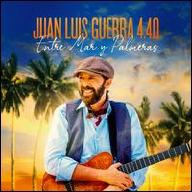Guerra is the son of a professional baseball player and grew up next to the National Music Gallery. As a teen, he was influenced by the Beatles and the music of U.S. hippies. Initially, he taught himself the basics of guitar playing, but after winning a contest, he attended the National Conservatory on a scholarship. One of his instructors then helped him get into the prestigious Berklee College of Music in Massachusetts and introduced him to the many genres of jazz. In time, he missed the Dominican Republic and returned to experiment with blending local African-influenced music, folk songs, and jazz with his group 440. The band takes its name from the universal tuning pattern of the "A" note, 440 Hertz. The name was chosen by Guerra's brother, José Gilberto, who used to sit and watch them rehearse. One day he commented that they seemed so obsessed with staying in perfect tune that they should call themselves that.
Their debut album, Soplando, made little impact. For their next efforts, Mudanza y Acarreo and Mientras Más Lo Pienso Tu, Guerra and 440 began adding merengue and lightning-quick riffs of "perico ripiao," and suddenly found success with a young crowd tired of hearing the same old thing. The new music, called "bachata-merengue," soon won massive acclaim in the Dominican Republic. The group was selected by their government to represent the country in the International Music Festival of OTI, the Organization of Ibero American Television. In 1988, Guerra and 440 had one of their biggest hits, Ojalá Que Llueva Café, which became the third best-selling album in Latin America. That year he lost his lead vocalist, Maridalia Hernández, who left to pursue a solo career in Europe, leaving Guerra the new lead singer.
In 1991, he released Bachata Rose; its five hit singles propelled it to hit status throughout the Americas, netting Guerra his first Grammy in the U.S. The album was particularly popular in Los Angeles and soon Guerra and his band were touring the continental U.S. as well as the Latin tropics. His next album, Areito, caused controversy in the Dominican Republic for speaking out against social injustices that the desperately poor felt Guerra had never personally experienced. Still, he was given credit for his sincerity and interest in improving things in his oft-troubled homeland. Musically, Guerra changed directions again for 1995's effort Fogaraté. This album incorporated more of the increasingly popular African soukous music. His 1998 release, Ni Es Lo Mismo Ni Es Igual, garnered Guerra three Grammys for Best Merengue Performance, Best Tropical Song for "El Niagara en Bicicleta," and Best Engineered Album at the first annual Latin Grammy Awards in fall 2000.
After non-stop touring for nearly three years, Guerra took an extended break from recording. He emerged in 2004 with Para Ti, his first album of new studio material in six years. The album was greeted with widespread critical and popular acclaim. He won two awards at the 2005 Grammys. The single "Las Avispas" won in the Best Gospel Pop and Tropical Merengue categories -- the first time in the award ceremony's history that a song won in two categories simultaneously. Guerra once again toured relentlessly. He appeared alongside a heavyweight roster of stars at the Berklee College of Music's 50th anniversary concert -- Herbie Hancock, Michel Camilo, Pat Metheny, and Paul Simon were also on the bill. He was featured as an opening act on U2's 360 tour as well as for the Rolling Stones' A Bigger Bang tour.
His next album, La Llave de Mi Corazón, was released in the early spring of 2007. It entered the Billboard Latin charts at number one and remained there for four weeks. He won three Latin Grammys for the album. In 2010, he appeared as a duet partner on Enrique Iglesias' single "Cuando Me Enamoro" and appeared in the music video. The record hit the top spot on Billboard's Latin chart and reigned there for 17 weeks. This was followed by a pre-release single, "Bachata en Fukuoka," from his forthcoming Asondeguerra album in 2010. The single hit number one, knocking the duet entry off its peak. Guerra's next offering was a live outing that documented the previous album's tour entitled Asondeguerra Tour; issued in May of 2013 it included fan favorites and reached the upper rungs of the Tropical charts.
In October of 2014, Guerra released the single and video for "Tus Besos," a bachata track heavily inspired by and flavored with the sound of early-'60s doo wop. Its video continued to garner airplay a full year later ultimately netting more than 200 million views, while the single hit the top spot on several industry and airplay charts. He followed it with the studio album Todo Tiene Su Hora in November. It was ultimately certified platinum, and landed at the top of the charts, netting him a 2015 Latin Grammy for Album of the Year.
In 2019, Guerra and 440 tipped off their fan base that an album was about to arrive with the release of the single and video for "Kitipun." Shot in a Tik Tok-esque story style, it quickly ran up both streaming and industry charts. The summery full-length Literal was issued in May and showcased a plethora of styles including bachata, merengue, salsa, jazz, and pop. While it peaked at 31 on the Latin albums charts, it hit seven on the Tropical albums list and attained gold certification. ~ Sandra Brennan & Thom Jurek, Rovi


















